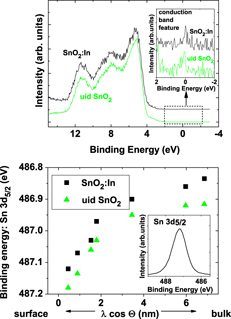Crossref Citations
This article has been cited by the following publications. This list is generated based on data provided by
Crossref.
Bierwagen, Oliver
Nagata, Takahiro
White, Mark E.
Tsai, Min-Ying
and
Speck, James S.
2012.
Electron transport in semiconducting SnO2 : intentional bulk donors and acceptors, the interface, and the surface – CORRIGENDUM.
Journal of Materials Research,
Vol. 27,
Issue. 19,
p.
2578.
Bierwagen, Oliver
and
Speck, James S.
2012.
Mg acceptor doping of In2O3 and overcompensation by oxygen vacancies.
Applied Physics Letters,
Vol. 101,
Issue. 10,
Preissler, Natalie
Bierwagen, Oliver
Ramu, Ashok T.
and
Speck, James S.
2013.
Electrical transport, electrothermal transport, and effective electron mass in single-crystalline In2O3films.
Physical Review B,
Vol. 88,
Issue. 8,
Bierwagen, Oliver
White, Mark E.
Tsai, Min-Ying
and
Speck, James S.
2013.
Molecular Beam Epitaxy.
p.
347.
Watanabe, Ken
Ohsawa, Takeo
Sakaguchi, Isao
Bierwagen, Oliver
White, Mark E.
Tsai, Min-Ying
Takahashi, Ryosuke
Ross, Emily M.
Adachi, Yutaka
Speck, James S.
Haneda, Hajime
and
Ohashi, Naoki
2014.
Investigation of charge compensation in indium-doped tin dioxide by hydrogen insertion via annealing under humid conditions.
Applied Physics Letters,
Vol. 104,
Issue. 13,
Mogilatenko, Anna
Kirmse, Holm
Bierwagen, Oliver
Schmidbauer, Martin
Tsai, Min‐Ying
Häusler, Ines
White, Mark E.
and
Speck, James S.
2014.
Effect of heavy Ga doping on defect structure of SnO2 layers.
physica status solidi (a),
Vol. 211,
Issue. 1,
p.
87.
Vasheghani Farahani, S. K.
Veal, T. D.
Mudd, J. J.
Scanlon, D. O.
Watson, G. W.
Bierwagen, O.
White, M. E.
Speck, J. S.
and
McConville, C. F.
2014.
Valence-band density of states and surface electron accumulation in epitaxialSnO2films.
Physical Review B,
Vol. 90,
Issue. 15,
Feneberg, Martin
Lidig, Christian
Lange, Karsten
White, Mark E.
Tsai, Min Y.
Speck, James S.
Bierwagen, Oliver
and
Goldhahn, Rüdiger
2014.
Anisotropy of the electron effective mass in rutile SnO2 determined by infrared ellipsometry.
physica status solidi (a),
Vol. 211,
Issue. 1,
p.
82.
Bierwagen, Oliver
2015.
Indium oxide—a transparent, wide-band gap semiconductor for (opto)electronic applications.
Semiconductor Science and Technology,
Vol. 30,
Issue. 2,
p.
024001.
Papadogianni, Alexandra
White, Mark E.
Speck, James S.
Galazka, Zbigniew
and
Bierwagen, Oliver
2015.
Hall and Seebeck measurements estimate the thickness of a (buried) carrier system: Identifying interface electrons in In-doped SnO2 films.
Applied Physics Letters,
Vol. 107,
Issue. 25,
Haeberle, J.
Machulik, S.
Janowitz, C.
Manzke, R.
Gaspar, D.
Barquinha, P.
and
Schmeißer, D.
2016.
Gap states in the electronic structure of SnO2 single crystals and amorphous SnOx thin films.
Journal of Applied Physics,
Vol. 120,
Issue. 10,
Jiang, Jie
Lu, Yinmei
Kramm, Benedikt
Michel, Fabian
Reindl, Christian T.
Kracht, Max E.
Klar, Peter J.
Meyer, Bruno K.
and
Eickhoff, Martin
2016.
Nitrogen incorporation in SnO2 thin films grown by chemical vapor deposition.
physica status solidi (b),
Vol. 253,
Issue. 6,
p.
1087.
Weidner, Mirko
Jia, Junjun
Shigesato, Yuzo
and
Klein, Andreas
2016.
Comparative study of sputter‐deposited SnO2 films doped with antimony or tantalum.
physica status solidi (b),
Vol. 253,
Issue. 5,
p.
923.
Jiang, Jie
Lu, Yinmei
Meyer, Bruno K.
Hofmann, Detlev M.
and
Eickhoff, Martin
2016.
Shift of optical absorption edge in SnO2 films with high concentrations of nitrogen grown by chemical vapor deposition.
Journal of Applied Physics,
Vol. 119,
Issue. 24,
Watanabe, Ken
Sakaguchi, Isao
Hashiguchi, Minako
Saito, Noriko
Ross, Emily M.
Haneda, Hajime
Ohsawa, Takeo
and
Ohashi, Naoki
2016.
Isotope tracer investigation and ab-initio simulation of anisotropic hydrogen transport and possible multi-hydrogen centers in tin dioxide.
Journal of Applied Physics,
Vol. 119,
Issue. 22,
Jiang, Jie
Ostheim, Lars
Kleine-Boymann, Matthias
Hofmann, Detlev M.
Klar, Peter J.
and
Eickhoff, Martin
2017.
Evidence for nitrogen-related deep acceptor states in SnO2 grown by chemical vapor deposition.
Journal of Applied Physics,
Vol. 122,
Issue. 20,
Jiang, Jie
Ostheim, Lars
Hartung, David
Lu, Yinmei
Hofmann, Detlev M.
Eickhoff, Martin
and
Klar, Peter J.
2017.
Transport mechanisms in SnO2:N,H thin film grown by chemical vapor deposition.
physica status solidi (b),
Vol. 254,
Issue. 7,
Papadogianni, Alexandra
Kirste, Lutz
and
Bierwagen, Oliver
2017.
Structural and electron transport properties of single-crystalline In2O3 films compensated by Ni acceptors.
Applied Physics Letters,
Vol. 111,
Issue. 26,
Vogt, Patrick
and
Bierwagen, Oliver
2018.
Quantitative subcompound-mediated reaction model for the molecular beam epitaxy of III-VI and IV-VI thin films: Applied to
Ga2O3
,
In2O3
, and
SnO2.
Physical Review Materials,
Vol. 2,
Issue. 12,
Bierwagen, Oliver
and
Galazka, Zbigniew
2018.
The inherent transport anisotropy of rutile tin dioxide (SnO2) determined by van der Pauw measurements and its consequences for applications.
Applied Physics Letters,
Vol. 112,
Issue. 9,



